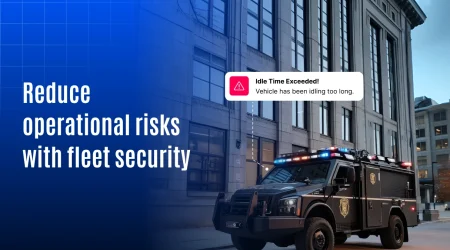Why Should Enterprises Invest in Indoor Location Tracking Software in California
Think about a warehouse supervisor starting the day. Orders are piling up, but a critical shipment can’t be found. Workers spread out to search every aisle, losing valuable time. Or picture a nurse who needs a monitor for an emergency patient. The device isn’t in its usual place, and the search begins. Minutes pass, and stress builds while care is delayed. That’s why more businesses are exploring indoor location tracking software in California.
These scenes aren’t rare. They’re everyday stories in places where space is massive, operations are complex, and stakes are high.
What changes with indoor tracking software
Now replay those stories with indoor tracking in place. In the warehouse, the supervisor checks a screen. A small dot on the map shows exactly where the shipment is. Workers head straight to it. The shipment leaves on time. Customers stay happy.
In the hospital, the nurse pulls up the system. The monitor’s location flashes instantly. Within moments, it’s by the patient’s side. Care continues without delay. The difference is not small. It’s the shift from uncertainty to clarity. From searching to knowing. From reacting to being prepared.
The impact you can measure after implementing indoor tracking software
Stories like these feel powerful, but the real impact shows up in numbers. Enterprises that adopt indoor location tracking often see:
- 20–30% savings in operational costs by cutting wasted time and labor.
- Hospitals free up hundreds of staff hours each month that go back into patient care.
- Manufacturers can reduce downtime by up to 40% when tools and equipment are always within reach.
These aren’t just statistics. They’re proof that small changes inside a building ripple outward – improving customer satisfaction, patient outcomes, and bottom lines.
Features that make this indoor tracking system work
Indoor location tracking isn’t just a map on a screen – it’s a set of tools built to solve real problems for enterprises. Here’s how the core features create value:
Real-time maps for instant visibility
No more second-guessing. Whether it’s a forklift in a warehouse, a monitor in a hospital, or staff inside a restricted zone, enterprises see everything live on a digital map. This helps supervisors act quickly and keep operations running smoothly. This visibility is made possible through an indoor positioning system that accurately tracks assets in real-time.
Smart movement alerts for better control.
The system doesn’t just track – it warns. If an asset enters a no-go area or equipment is taken without authorization, managers get an alert immediately. This reduces theft, improves safety, and ensures resources are always where they should be.
Heat maps to understand patterns
The system creates heat maps that show how space is actually used. Warehouses can see which aisles are busiest, hospitals can track patient movement, and factories can identify areas where workflow slows down. These insights help the indoor location system for enterprise redesign layouts, balance workloads, and boost efficiency.
Historical data for planning and compliance
Enterprises in California face strict audits and reporting. Indoor tracking logs every movement, creating a reliable digital record. Managers can analyze patterns, check utilization rates, and present accurate data during compliance checks.
Easy integration with existing systems
Enterprises don’t need to overhaul their IT setup. Indoor tracking software connects with ERP systems, IoT devices, and even workforce apps already in use. This means faster deployment, less training, and quicker results.
Scalability across industries and sites
The system works just as well for one warehouse as it does for a statewide network of hospitals. Enterprises can start small and expand as needed, without worrying about limitations.
These features are designed for decision-makers who want clarity, control, and compliance in complex environments like California’s warehouses, hospitals, and logistics hubs.
Why It Matters for System Integrators
For system integrators in California, indoor location tracking software isn’t just another product – it’s a business growth opportunity. Here’s why:
High demand across industries
From warehouses and logistics hubs to hospitals and tech campuses, every sector in California is struggling with visibility inside buildings. Offering this solution puts integrators at the center of a growing market.
Recurring revenue potential
Enterprises don’t use the software once and forget it. They rely on it daily for compliance, safety, and operations. That means steady revenue streams through subscriptions, support, and scaling.
Cross-industry flexibility
The same platform works for logistics, healthcare, manufacturing, and retail. Integrators don’t need to chase different products for different clients – one solution serves many sectors.
Stronger client relationships
By helping enterprises cut costs and boost efficiency, integrators become trusted advisors rather than just vendors. This makes renewals and upselling much easier. Exploring the benefits of implementing an indoor navigation system can further improve their value proposition, making renewals and upselling much easier. Many integrators also repurpose success stories into quick, engaging clips using an Instagram reel maker to showcase results to potential clients.
Future-proof portfolio
Indoor tracking aligns with California’s push for IoT adoption, compliance, and sustainability. Integrators who sell it position themselves as leaders in modern enterprise solutions.
The Last Conclusion
Indoor location tracking software in California is no longer a future investment; It’s a present-day necessity for enterprise in the United States. Whether you’re managing warehouses, hospitals, or patient movement. The software brings clarity, which adds business value. The right indoor tracking solution acts as a digital backbone for modern logistics and facility management. With today’s technology, this is the moment of opportunity to act on, evolve, and move forward.



